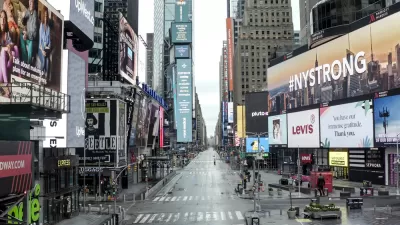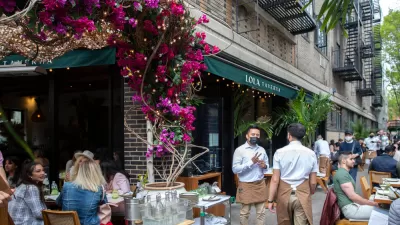Cities could learn from the grocery store chain's successful navigation of the uncertainty of the COVID-19 pandemic.

The pandemic has thrown the benefits of urban density into doubt as recently untethered work-from-home employees flee city centers, driven by fear of COVID-19, lack of the usual draws like nightclubs and restaurants, and lower costs of living elsewhere. As people hunker down at home and grocery stores become major sites of outbreaks, one grocery chain has managed to implement low-cost but wildly effective measures to keep its employees safe and its sales at pre-pandemic levels. According to Nate Cherry, Trader Joe's has managed to "incentivize the right, community-oriented behaviors" using "functional problem-solving, practical solutions, better data mining and analysis, and more flexibility" that have helped the popular chain thrive during the pandemic.
Trader Joe's,with an employee infection rate of 2.4% (far below the 20% averaged by other grocery stores) has implemented small but powerful changes that offer valuable lessons for cities. As a hyper-local amenity, their stores mainly serve users that live within on or two miles, reducing customers' reliance on transportation for basic necessities—a worthy goal for neighborhoods and a cornerstone of the recent "15-minute city" movement. The store also provides an excellent example of space management in their parking lots. "Similarly, one of the easiest things we can do as planners is to more intelligently manage the infrastructure we have — specifically, sidewalks, which can be better structured to accommodate passive and active areas, as well as seating and landscape areas." Other tools that would be useful anywhere include sanitation infrastructure(in the case of Trader Joe's, visible hand-washing stations), attention to proper ventilation, and a flexibility to implement temporary solutions quickly and cost-effectively.
Planners must look for the opportunities and tweaks that will allow us to resume urban life with all the things we love about it more safely and equitably. "Our cities of tomorrow might be much like the ones of today, just a bit less crowded, with access to more resources and managed with greater responsiveness — like your favorite grocery store."
FULL STORY: 5 lessons Trader Joe’s can teach the city of the future

Planetizen Federal Action Tracker
A weekly monitor of how Trump’s orders and actions are impacting planners and planning in America.

San Francisco's School District Spent $105M To Build Affordable Housing for Teachers — And That's Just the Beginning
SFUSD joins a growing list of school districts using their land holdings to address housing affordability challenges faced by their own employees.

The Tiny, Adorable $7,000 Car Turning Japan Onto EVs
The single seat Mibot charges from a regular plug as quickly as an iPad, and is about half the price of an average EV.

With Protected Lanes, 460% More People Commute by Bike
For those needing more ammo, more data proving what we already knew is here.

In More Metros Than You’d Think, Suburbs are Now More Expensive Than the City
If you're moving to the burbs to save on square footage, data shows you should think again.

The States Losing Rural Delivery Rooms at an Alarming Pace
In some states, as few as 9% of rural hospitals still deliver babies. As a result, rising pre-term births, no adequate pre-term care and "harrowing" close calls are a growing reality.
Urban Design for Planners 1: Software Tools
This six-course series explores essential urban design concepts using open source software and equips planners with the tools they need to participate fully in the urban design process.
Planning for Universal Design
Learn the tools for implementing Universal Design in planning regulations.
Smith Gee Studio
City of Charlotte
City of Camden Redevelopment Agency
City of Astoria
Transportation Research & Education Center (TREC) at Portland State University
US High Speed Rail Association
City of Camden Redevelopment Agency
Municipality of Princeton (NJ)





























